Sintra-Portugal.com
The best independent guide to Sintra
Sintra-Portugal.com
The best independent guide to Sintra
A Guide to the Palaces of Sintra for 2025
Sintra is a remarkable town, famed for its stunning collection of palaces, castles, and grand villas. For first-time visitors, the sheer number of amazing sights can be confusing, especially when you only know you want to see the "Sintra palaces".
This guide will introduce you to the main palaces of Sintra, helping you identify each one and decide which are the best to include in your trip. The five most famous palaces are the colourful Palácio da Pena, the mystical Quinta da Regaleira, the historic Palácio Nacional de Sintra, the tranquil Palácio de Monserrate and the Gothic Biester Palace. Alongside these is the ancient Moorish Castle (Castelo dos Mouros), whose walls climb the highest hills of the Serra de Sintra.
This article will help you choose which of Sintra's incredible monuments to visit.
Which Sintra Palace Should You Visit?
Each of Sintra’s monuments offers a very different experience. The following section will help you decide which attractions will be the highlights of your day trip.
Palácio da Pena
The Pena Palace is the fantastical, brightly coloured palace that sits high on a hilltop overlooking the entire region. It is a wonderful example of 19th-century Romanticism, with decorative battlements, statues of mythical creatures, and vividly painted terraces. As Sintra's most famous attraction, it is always extremely busy, and tickets with timed entry slots must be booked far in advance.
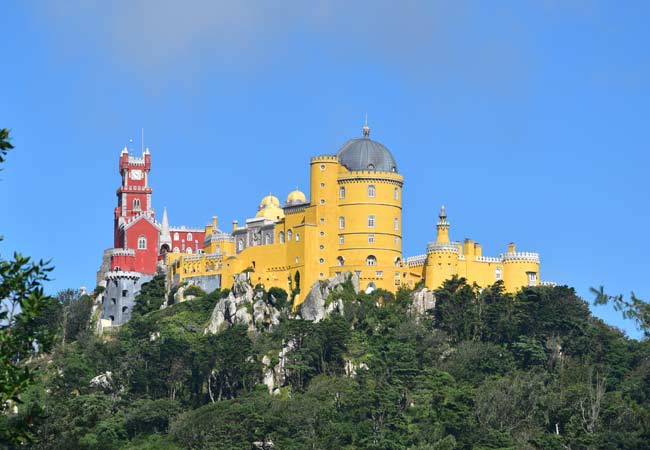
Quinta da Regaleira
This estate is famous for its enchanting gardens, which are filled with hidden tunnels, secret passages, and mysterious symbolism. The main attraction is not the decorative gothic mansion but the grounds, which contain the incredible Poço Iniciático (Initiation Well), a stone tower that spirals deep into the earth. It is a fun and intriguing place to explore.
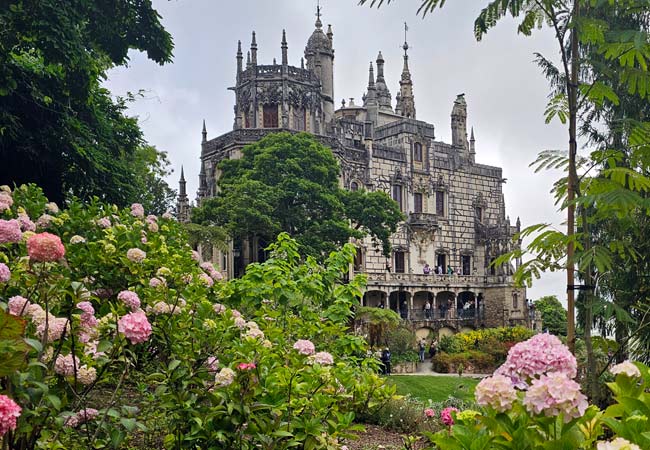
Palácio Nacional de Sintra
Located right in the heart of the old town, this is the best-preserved medieval royal palace in Portugal. It's instantly recognisable by its two giant, cone-shaped kitchen chimneys, which have become a symbol of the town. A visit offers a journey through centuries of Portuguese history, as it was continuously used by the monarchy from the 15th to the 19th century.
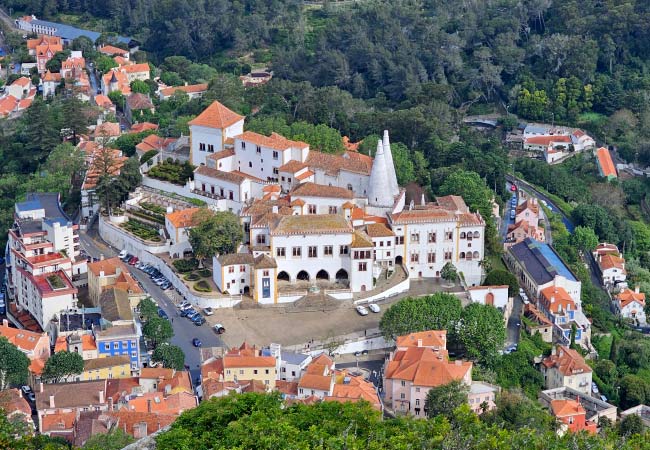
Castelo dos Mouros
While technically a castle and not a palace, the Moorish Castle is an essential Sintra sight. These 9th-century ruins snake over a high, rocky ridge and offer a fantastic walk along the ancient battlements. From the walls, you get outstanding views of the Pena Palace and the historic town below.
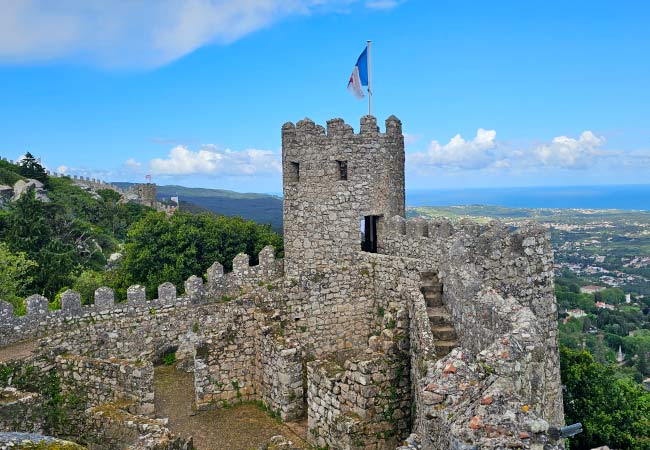
Palácio de Monserrate
This exquisite, exotic villa is a hidden gem. The palace itself combines Gothic, Indian, and Moorish architectural styles to create a truly unique building. It is set within some of Sintra's most diverse botanical gardens, which include a Mexican garden, a Japanese garden, and a romantic ruined chapel. Monserrate Palace offers a much more peaceful experience than the main sights.
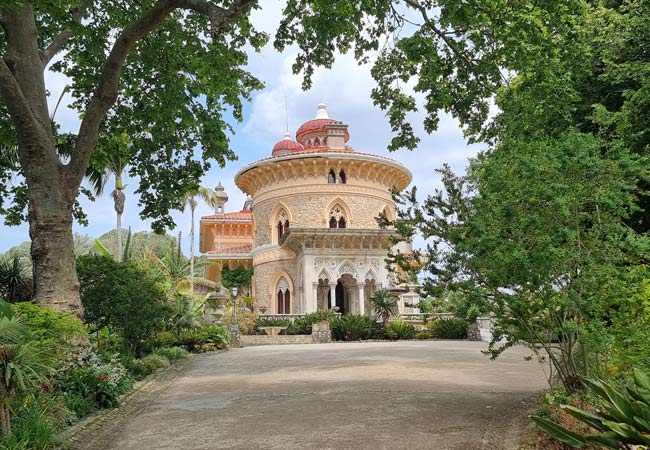
Palácio Biester
One of the newest additions to Sintra's public monuments, the Palácio Biester offers a darker, more atmospheric experience. This late 19th-century villa is a fantastic example of Neo-Gothic design, with interiors filled with detailed woodwork and surrounded by an impressive botanical park. Biester is an excellent choice for those looking to explore a less crowded, yet equally fascinating, Sintra attraction.
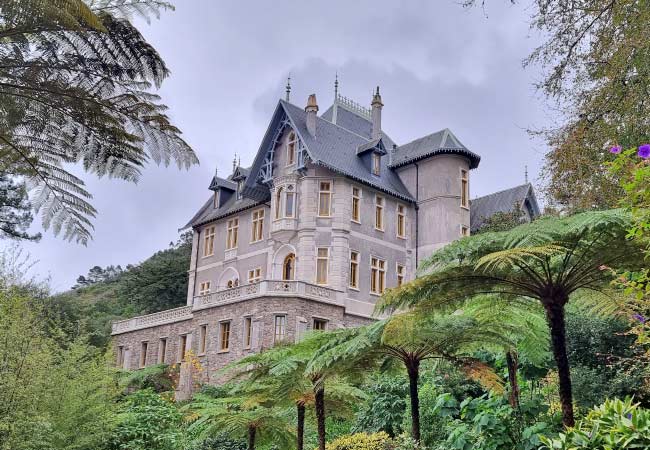
Tourist Information for Sintra's Palaces
Planning your visit to Sintra requires understanding the logistics for each monument, as they vary significantly in price, location, and how busy they get. Below is essential information to help you structure your day.
Palácio da Pena
The vibrant and iconic palace high on the hill.
• Entrance Fee: The full ticket to the palace and park costs €20 for an Adult (18 - 65 years), €18 for a Youth (6 - 17 years) and €18 for a Senior (+65 years), with free entry for children (up to 5 years). Timed entry slots for the palace interior are strictly enforced.
• A cheaper ticket, which only grants access to the park and the palace terraces (not the interior state rooms), is available for €10 for an Adult, and €9 for both Youths and Seniors.
• How Long to Explore: Plan for a minimum of 3 hours. This includes 45-60 minutes for the palace interior, at least an hour for the terraces and immediate grounds, and the steep 15-minute walk from the main entrance to the palace itself. Exploring the wider Parque da Pena can easily extend your visit to half a day.
• Peak Season Crowds: Extremely busy. This is Sintra's most popular attraction, and you should expect very large crowds, long queues to enter the palace (even with a timed ticket), and packed terraces from mid-morning until late afternoon. Each ticket is assigned a strict 30-minute time slot for entry into the state rooms.
• Location & Getting There: It is situated on the second-highest peak of the Serra de Sintra, a steep 4.5km from the historic town centre. The uphill walk is very demanding. The best way to get there is the 434 tourist bus, which departs from outside Sintra train station.
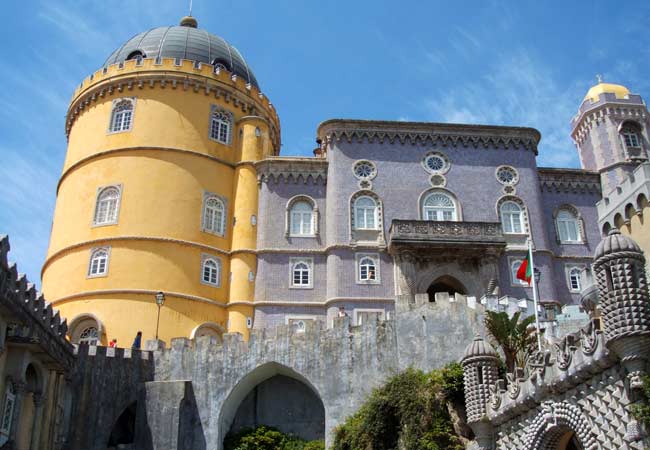
Quinta da Regaleira
The mysterious estate with its famous initiation well and hidden gardens.
• Entrance Fee: A standard adult ticket costs €15, with a reduced price of €10 for Youths and Seniors.
• How Long to Explore: Allow 2 to 2.5 hours. The majority of your time will be spent exploring the fascinating gardens, finding hidden tunnels, and queueing for the Initiation Well. The palace interior is interesting but takes less than 30 minutes to see.
• Peak Season Crowds: Very busy. While not as crowded as Pena Palace, the narrow paths and key attractions like the Initiation Well can have long queues, sometimes up to an hour during peak times.
• Location & Getting There: It is a relatively flat 10-minute walk (800m) from the centre of the historic town. You can also take the 435 bus from the train station, which stops directly outside.
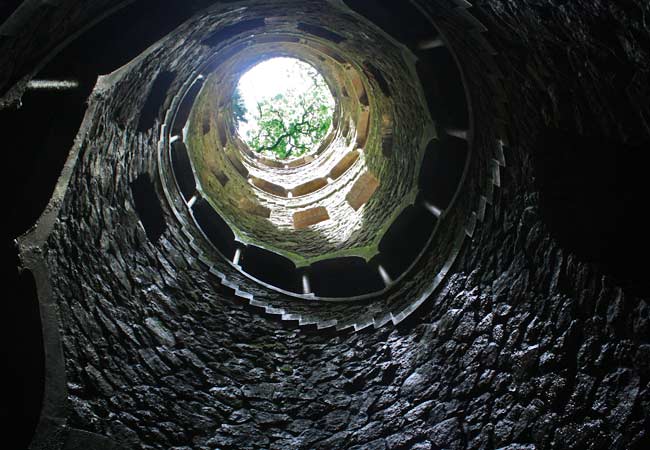
The Poço Iniciático (Initiation Well)
Palácio Nacional de Sintra
The medieval palace in the heart of the old town, distinguished by its twin conical chimneys.
• Entrance Fee: An adult ticket costs €13, with a reduced price of €10 for Youths and Seniors, while children enter for free. Due to its central location, it is easy to visit, and tickets can usually be purchased on the day of your visit without issue.
• How Long to Explore: A visit typically lasts between 60 and 90 minutes. The route through the palace's many historic rooms is well-laid-out and informative.
• Peak Season Crowds: Moderately busy. It receives a steady stream of visitors but rarely feels uncomfortably crowded, making it a good option to visit during the middle of the day when other sites are at their busiest.
• Location & Getting There: It is located in the main square of the historic centre of Sintra and is impossible to miss. It is a 15-minute walk from the train station.

Castelo dos Mouros
The ancient castle ruins with incredible stone walls and panoramic views.
• Entrance Fee: The entrance fee is €12 for an adult, €10 for Youths and Seniors, with free entry for children.
• How Long to Explore: Plan for 1.5 to 2 hours. This gives you enough time to walk the full length of the battlements, climb the towers, and appreciate the stunning views of Pena Palace and the town below.
• Peak Season Crowds: Busy. The pathways on the walls are narrow, so they can feel crowded at popular times. However, the open-air nature of the site means it absorbs crowds better than the enclosed palaces.
• Location & Getting There: The castle is situated on a hill just below the Palácio da Pena. It is a very strenuous uphill walk from the town centre. The 434 tourist bus is the recommended method of travel; it stops at the castle entrance before continuing to Pena Palace.
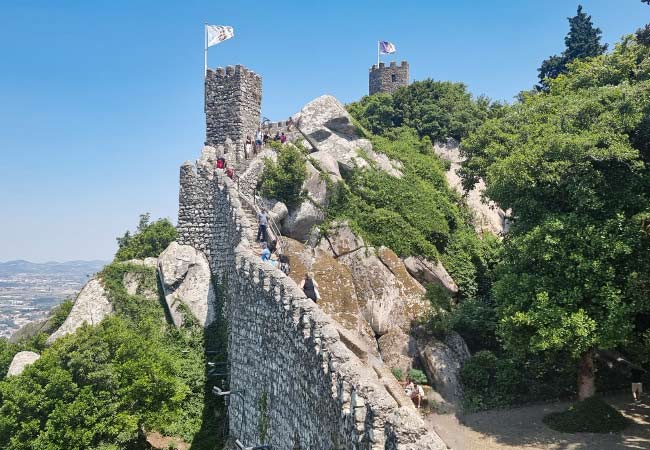
Palácio de Monserrate
The beautiful and tranquil Indian-inspired villa set in lush botanical gardens.
• Entrance Fee: An adult ticket costs €12, Youths and Seniors pay €10, and children have free entry.
• How Long to Explore: Around 2 hours is ideal. This allows for 30-40 minutes inside the intricately decorated villa and over an hour to wander through the diverse gardens, including the Mexican and Japanese sections and the ruined chapel.
• Peak Season Crowds: Peaceful. This is the least visited of Sintra's main sights, offering a calm experience even at the height of summer. You will find no significant queues here.
• Location & Getting There: Monserrate is located 3.5km west of the historic centre. It is too far to walk for most visitors. The 435 bus service from the train station is the best public transport option. If you are driving, this is one of the few Sintra monuments with ample car parking.
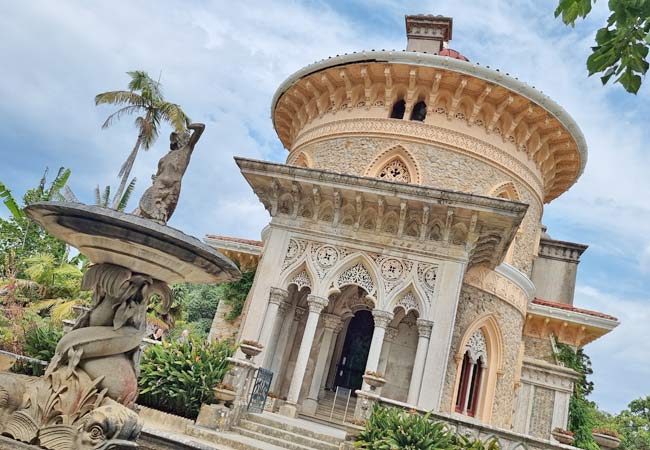
Palácio Biester
The atmospheric Neo-Gothic villa with rich interiors and a cinematic history.
• Entrance Fee: An adult ticket costs €14, while Youths and Seniors pay €9, with free entry for children.
• How Long to Explore: A typical visit takes around 90 minutes. This provides sufficient time to admire the detailed art and architecture inside the palace and take a pleasant walk through its surrounding park.
• Peak Season Crowds: Quiet to moderately busy. As one of Sintra's newer attractions for the public, it remains less discovered than its famous neighbours, offering a more relaxed visit.
• Location & Getting There: The palace is conveniently located just a 5-minute walk from Quinta da Regaleira and a 10-minute walk from the historic centre, making it very easy to incorporate into a walking tour of the town.
The Interconnected stories of Sintra's Palaces
While each of Sintra's palaces has its own distinct identity, they are not isolated monuments. They are woven together by a web of shared owners, artistic vision, and the very landscape they occupy. Understanding these connections offers a richer way to see the town.
The most significant link is through King Ferdinand II, the creative force behind the 19th-century transformation of Sintra. His ultimate project was the Palácio da Pena, which he commissioned to be built from the ruins of an old monastery. From this high perch, the ancient walls of the Castelo dos Mouros were a dominant feature of the landscape. Instead of ignoring them, Ferdinand acquired the castle ruins and incorporated them into the grounds of his palace, restoring the walls to serve as a romantic, historical feature in his panoramic garden.
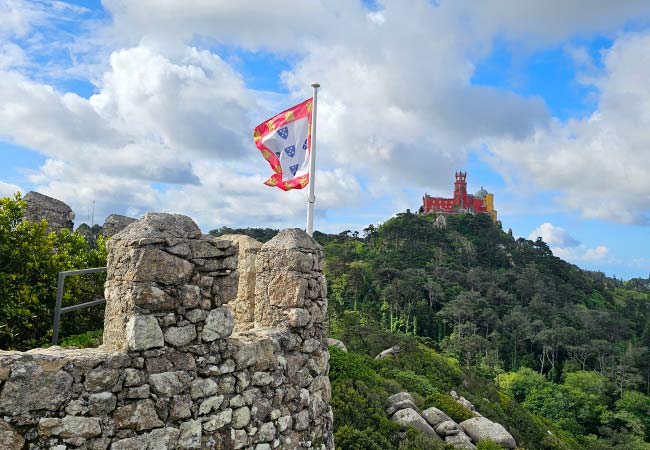
The two monuments were designed to be viewed together, a direct and intentional connection between royal fantasy and ancient history. Both of these hilltop properties looked down upon the Palácio Nacional de Sintra, the historic seat of the Portuguese monarchy and the official royal residence in the town for centuries. Together, these three sites represent the past and present of the Portuguese Crown's presence in Sintra.
A different, but equally strong, connection exists between two of Sintra's most imaginative private estates. The Quinta da Regaleira and the Palácio Biester share the same artistic mastermind: Luigi Manini. An Italian opera set designer and architect, Manini was first commissioned by the wealthy businessman Frederico Biester for the Biester Palace's interiors. Soon after, he was hired by the millionaire Carvalho Monteiro for the grander project of Quinta da Regaleira.
This shared creator is why both properties have a theatrical, mysterious, and richly detailed feel, filled with Neo-Gothic and Romantic elements. They are artistic siblings, born from the same creative mind. This connection is made all the more tangible by their physical proximity; the two estates are direct neighbours, sitting side-by-side on the road leading from Sintra's historic centre.
Finally, the Palácio de Monserrate, while commissioned by an Englishman, Sir Francis Cook, is connected by the spirit of the age. It is another prime example of a 19th-century millionaire being drawn to Sintra's enchanting landscape to build a personal, romantic paradise. Just as Ferdinand II brought German romanticism to Pena, Cook brought an English garden aesthetic and exotic, Indian-inspired architecture to his estate. It stands as a parallel vision to Pena, showcasing how Sintra became a canvas for the grand, personal projects of Europe's elite during the same era.
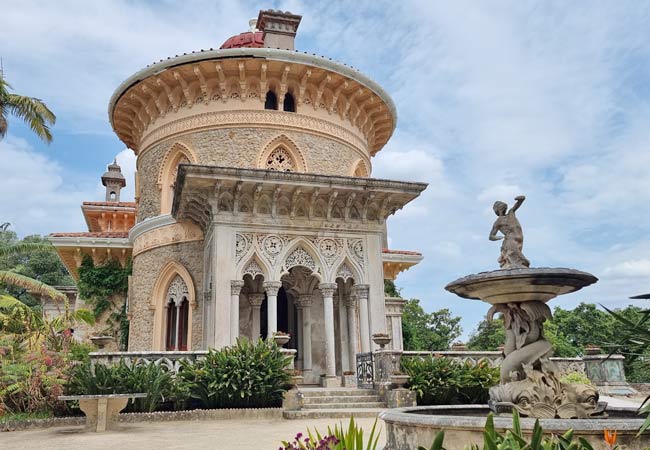
The Three Great Ages of Sintra's Palaces
Sintra's monuments were not built in isolation. They are products of three distinct historical eras, each with its own motivations and ambitions. Understanding this timeline provides a clear story of how Sintra evolved from a place of royal power to a canvas for personal fantasy.
The Age of Kings and Moors (8th to 16th Centuries)
This foundational era was defined by strategic power and the consolidation of the Portuguese monarchy. The oldest structure is the Castelo dos Mouros, with its origins in the 8th and 9th centuries. Its position high on the mountain ridge was purely for military defence and control of the surrounding lands.
Centuries later, the focus of power shifted down the hill to the Palácio Nacional de Sintra. With its major developments occurring in the 15th and 16th centuries, it became the ceremonial and administrative heart of the kingdom when the court was in residence. Its evolution over 500 years makes it a living document of Portuguese royal history.
The Romantic Revolution (19th Century)
The 19th century transformed Sintra into an international hub for the ideals of Romanticism, where personal expression and a deep appreciation for nature became the driving forces behind new constructions. This movement was led by King Ferdinand II, whose passion project, the Palácio da Pena, was constructed between 1842 and 1885. It was a purely artistic endeavour, a fantasy palace built not for governance, but for the dramatic views and as a statement of personal taste.
During this same period, wealthy foreigners were drawn to Sintra's unique landscape. Between 1858 and 1863, the English industrialist Sir Francis Cook built his own exotic vision, the Palácio de Monserrate, proving that Sintra had become a prestigious stage for Europe’s elite to create their own private paradises.
The Age of Mystics and Millionaires (late 19th to early 20th Centuries)
The final great building phase in Sintra was driven by wealthy individuals with a deep interest in esoteric knowledge and symbolism. This period saw the creation of two neighbouring estates conceived as landscapes of meaning.
The Palácio Biester, constructed between 1880 and 1890, was the first of these unique villas. It was quickly followed by the grander vision of the Quinta da Regaleira, largely completed by 1910. Both estates were built for private patrons fascinated with mythology and ancient orders. The grounds, particularly at Regaleira, were designed not just for leisure but as a symbolic journey, making them the ultimate expression of this era of private, mystical pursuits.
Our most popular guides to Sintra
If you've found our content valuable, we'd welcome your support.
The digital publishing landscape has evolved significantly. As a small independent publisher, we face growing challenges. Search engines increasingly favour paid content over organic results, while AI-generated content often reproduces original work without attribution.
To support our work, please consider bookmarking this page (press Ctrl + D) for quick access. If you find an article helpful, we'd be grateful if you'd share it with friends on social media.
For specific questions, please see our Reddit community at r/LisbonPortugalTravel.
Should you notice any outdated or incorrect information, please contact us at [email protected]
Thank you for helping us continue to provide valuable content in an increasingly challenging digital environment.
A complete list of all of our Sintra and Lisbon guides
If you've found our content valuable, we'd welcome your support.
The digital publishing landscape has evolved significantly. As a small independent publisher, we face growing challenges. Search engines increasingly favour paid content over organic results, while AI-generated content often reproduces original work without attribution.
To support our work, please consider bookmarking this page (press Ctrl + D) for quick access. If you find an article helpful, we'd be grateful if you'd share it with friends on social media.
For specific questions, please see our Reddit community at r/LisbonPortugalTravel.
Should you notice any outdated or incorrect information, please contact us at [email protected]
Thank you for helping us continue to provide valuable content in an increasingly challenging digital environment.





























